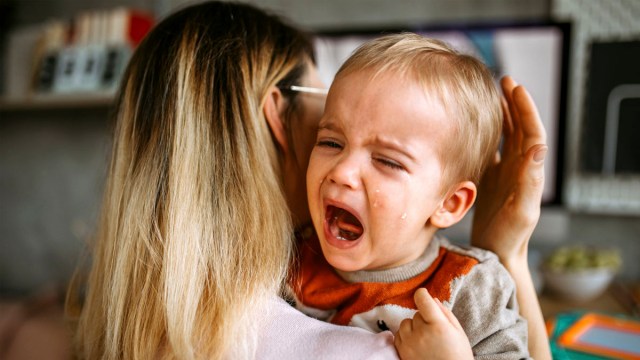It’s the middle of the night, and you wake to your toddler screaming in her room. You find her sitting upright in bed with her eyes wide open, but she hits and kicks when you try to comfort her. After a few minutes, she falls back to sleep, and in the morning, she doesn’t remember that any of this happened. Night terrors in toddlers can be upsetting for parents to witness, says Dr. Binal Kancherla, pediatric sleep specialist and medical director of the Children’s Sleep Center at Texas Children’s Hospital. “It can seem as if they’re possessed because they’re still sleeping.”
Some children can be very active during a night terror, also known as a sleep terror. Sometimes they’ll even run away from well-meaning parents—sleepwalking goes hand-in-hand with night terrors—but they actually have no control over their behavior. “The key feature of night terrors is that they are still asleep when any of these behaviors occur,” Kancherla says. Here’s everything you need to know about night terrors in toddlers.
What are night terrors?
Night terrors in children happen during the deepest and most restorative phase of sleep, which is called stage three or slow-wave sleep (SWS). Since children experience most SWS in the first half of the night, they are likelier to have night terrors within a few hours of bedtime. There isn’t a ton of research on the prevalence of sleep terrors, but estimates range from 1% to 6.5% of children—though one study found that 40% of kids under 5 had experienced one.
During night terrors, children may:
- Scream or yell
- Cry uncontrollably
- Thrash around, kick, and hit
- Sit upright in bed
- Get out of bed and run from their parents
- Stare into space
- Sweat or breathe heavily
- Look frightened
- Be unresponsive or resistant to comfort
Sleep terrors generally last for anywhere from a minute to upwards of 45 minutes, though an episode this long is rare and they most commonly last around 10 minutes. During this time, you won’t be able to wake your kid even though you’ll desperately want to help or comfort them.
Night terrors vs. nightmares: What’s the difference?
You can distinguish a night terror from a nightmare based on a few factors: whether they happen earlier or later in the night, their severity, and how frequently they occur. Nightmares take place during REM sleep, the fourth stage of the sleep cycle and the one that we reach in the second half of the night. Once a toddler wakes from a nightmare, they’ll likely call for their parents and seek comfort. Sometimes it takes them a little while to fall back asleep because they remember specific parts of their bad dreams. The next day, your child is also more likely to remember that they woke in the night.
Night terrors happen earlier in the night, just a few hours after bedtime, and a toddler having a sleep terror will be inconsolable and unresponsive to any attempts to help or comfort them. They appear awake but are totally unaware of what’s happening, and fall back asleep more suddenly once the episode ends. Kids who have had a night terror won’t remember any of it.
At what age do sleep terrors typically start and when do they go away?
If you’re experiencing night terrors with your toddler, you’re probably eager to know how long this frightening new phase will last. Night terrors can start as young as one year old and persist as late as 13 years of age, but most kids outgrow them by elementary school. A JAMA Pediatrics study found that the most common age for sleep terrors is 1.5 years old.
What causes night terrors in toddlers?
Night terrors are a normal part of child development, but there are a number of triggers that can make them more prevalent in some kids:
- Sleep deprivation (the most common trigger)
- Medications like antidepressants and Benadryl
- Illness accompanied by fever
- A family history of sleep terrors
- Excessive caffeine (for older kids)
And if you rely on melatonin to help your kids get the Zzz’s they need, fear not— it hasn’t been proven to cause night terrors.
Is there any way to prevent night terrors in kids?
The best thing parents can do is to ensure that their toddler is getting enough sleep. Children between one and 5 years of age need 12-15 hours of sleep on average (while school-aged kids need about 12 hours). “The best way to treat night terrors is to extend sleep,” Kancherla says.
How to help a toddler having a sleep terror
Unfortunately, parents can’t stop night terrors, and trying to wake them can be distressing and may even increase the chances of another sleep terror. The best thing you can do is check on your child to make sure they’re safe, and if they’re particularly active, you can gently hold them to prevent them from injuring themselves (it’s probably a good idea to have a baby gate at the top of your stairs, too). Beyond that, you simply have to let the episode pass. Luckily, most stop within 10 minutes. If your toddler is shaken after, you can cuddle and reassure them until they fall back asleep.
Are night terrors bad for kids? When to see a doctor
Night terrors are not harmful to children of any age. However, parents should talk to their pediatrician or family physician if their child doesn’t outgrow them by age 9 or 10, if the night terrors occur several times a night, or if the frequency is increasing. In rare cases, night terrors can be a sign of a medical problem like nocturnal seizures, which mimic night terrors.











